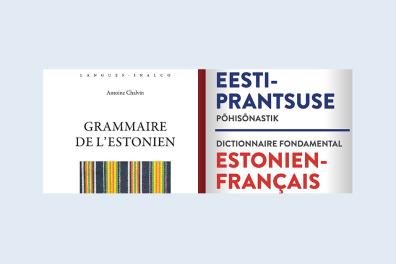Publication of Antoine Chalvin's works: Grammaire de l'estonien and Dictionnaire fondamental estonien-français

The Centre de Recherches Europes-Eurasie-CREE (Inalco) is pleased to announce the publication of books written by Antoine Chalvin: Grammaire de l'estonien, Paris, L'Asiathèque, 2023 and Dictionnaire fondamental estonien-français, Tartu, Tartu University Press, 2023.
Grammaire de l'estonien, Paris, L'Asiathèque, 2023, 384 p.
This book is the first to present Estonian grammar in depth in French. Along with Finnish and Hungarian, Estonian is one of the three main Finno-Ugric languages spoken in Europe. Along with the other languages of this family, it shares many features that distinguish it from Indo-European languages: a largely agglutinative morphology based on suffixation, a rich declension system (14 cases), the absence of articles and grammatical genders, the absence of the verb "to have", numerous postpositions, length oppositions for almost all vowels and consonants, etc. Estonian has also developed its own language, which is based on the use of the word "to have". Estonian has also developed a number of special features, such as a specific verbal mode for conveying reported information. In differentiating itself from Finnish, it lost some of its suffixes, which introduced numerous homonyms and irregularities into its nominal morphology. From its contacts with German, it has inherited a system of phrasal verbs and a tendency to place the verb at the end of a proposition in certain contexts. All this grammatical complexity is presented here in a methodical way, in a language accessible to the widest possible audience. The presentation is illustrated by short, constructed sentences and authentic examples - taken from literary works of the 20th and 21st centuries - which give a glimpse of the full expressive richness of the language.
Fundamental Estonian-French Dictionary, Tartu, Tartu University Press, 2023, 759 pp.
This Estonian-French dictionary is of a novel and seemingly paradoxical kind: it covers only 5000 words of the fundamental Estonian lexicon, but provides for each of them a very detailed treatment, comparable to that of a large bilingual dictionary. Its aim is not simply to describe vocabulary that can be used by intermediate-level learners. The basic Estonian lexicon is first and foremost a framework for organizing a large number of translated examples, carefully selected to illustrate the main difficulties and idiomatic richness of Estonian and French. This dictionary is therefore intended for all users of both languages, including the most experienced, who wish to further perfect their mastery of vocabulary and grammar and learn to express themselves more naturally. Each article is the fruit of the collaboration of Estonian and French editors. At all stages of the writing process, the work was based on a vast corpus of parallel texts in Estonian and French, as well as on the main Estonian textual corpora. This guarantees the relevance of the information provided, in particular the choice of the best French equivalents that can actually be used to translate the featured word, the precision of the indications guiding the user to the equivalent best suited to the nuance of meaning or context, the choice of Estonian examples and locutions and the quality of the translations offered of them.